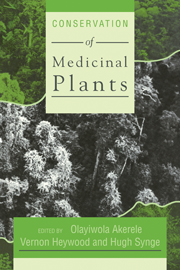Book contents
- Frontmatter
- Contents
- Contributors
- Preface
- Acknowledgements
- The Chiang Mai Declaration
- Introduction
- The Issue of Medicinal Plants
- Science, Industry and Medicinal Plants
- Techniques to Conserve Medicinal Plants
- Policies to Conserve Medicinal Plants
- 15 Policies and Organisation for Medicinal Plant Conservation in Sri Lanka
- 16 Experience in the Conservation of Medicinal Plants in Sri Lanka
- 17 The Conservation of Medicinal Plants Used in Primary Health Care in Thailand
- 18 Medicinal Plants and the Law
- 19 Let's Stop Talking to Ourselves: The Need for Public Awareness
- 20 Germplasm, Genetic Erosion and the Conservation of Indonesian Medicinal Plants
- Experiences from Programmes to Conserve Medicinal Plants
16 - Experience in the Conservation of Medicinal Plants in Sri Lanka
Published online by Cambridge University Press: 07 September 2010
- Frontmatter
- Contents
- Contributors
- Preface
- Acknowledgements
- The Chiang Mai Declaration
- Introduction
- The Issue of Medicinal Plants
- Science, Industry and Medicinal Plants
- Techniques to Conserve Medicinal Plants
- Policies to Conserve Medicinal Plants
- 15 Policies and Organisation for Medicinal Plant Conservation in Sri Lanka
- 16 Experience in the Conservation of Medicinal Plants in Sri Lanka
- 17 The Conservation of Medicinal Plants Used in Primary Health Care in Thailand
- 18 Medicinal Plants and the Law
- 19 Let's Stop Talking to Ourselves: The Need for Public Awareness
- 20 Germplasm, Genetic Erosion and the Conservation of Indonesian Medicinal Plants
- Experiences from Programmes to Conserve Medicinal Plants
Summary
At the commencement of Project 3320 in June 1986 (see previous paper), there was a bias towards in situ conservation. But as work got underway it became clear that there was a need for a simultaneous ex situ conservation as well. The main reason for this was the comparatively recent resurgence of Ayurveda (Indigenous Medicine) in Sri Lanka and its developments as an acceptable form of Alternative Medicine.
As the Sri Lanka Co-ordinator of the Project I saw the relevance of establishing a rapport between the in situ conservation authorities, namely the Forest Department and the Department of Wildlife Conservation (DWLC), and those involved in the cultivation of herbs in nurseries. The latter included the Ministry of Indigenous Medicine, which has several WHO-aided Nurseries scattered over the island, the Bandaranaika Memorial Ayurvedic Research Institute (BMARI) near Colombo, the Royal Botanic Gardens (RBG) in Peradeniya and several private growers. This rapport was established by forming at ministerial level a representative Committee to include all concerned.
I have worked closely with the different institutions named above and visited several private herbaria and would like to set down my findings briefly.
Identification of Plants
The main constraint to either form of conservation is the confusion regarding the correct identity of the plant. This has been caused by practitioners resorting to the use of localized vernacular names in prescriptions. These are often misleading as some plants have several synonyms, e.g. Rubia cordiflora has 4 sinhala names and 49 Sanskrit names. Quite often a synonym of one plant may become the common name of another. This confusion has led to substitutions, and more dangerously, to adulteration. The damage to the medical practice is obvious.
- Type
- Chapter
- Information
- Conservation of Medicinal Plants , pp. 249 - 252Publisher: Cambridge University PressPrint publication year: 1991



